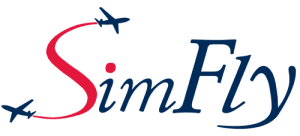About us
Scope of Work
SimFly Pty Ltd provides aircraft Cockpit Posters, Cockpit Procedure Trainers and Synthetic Flight Training Devices to both the professional and recreational flight training industry.
Company Background
A lack of similar training products available locally to the aviation industry prompted the incorporation of SimFly and the company initially began to supply to a niche market.
SimFly has since experienced rapid growth in the subsequent years and is now supplying products to major airlines and aviation flight training centres across the globe along with many other smaller flying schools and individuals.
To meet demand the company has increased its workforce and invested significantly in new production equipment and is now also increasing its research and development to provide some new and improved products to its customers.
Company Strategy
Purpose To be the leader in the supply of flight training material to the aviation training industry.
Vision To provide quality products that exceed the expectations of our customers.
Mission Statement To build long term relationships with our customers and provide exceptional customer service by pursuing business through innovation and increased technology.
Core values We believe in treating our customers with respect. We grow through creativity, invention and innovation. We integrate honesty, integrity and business ethics into all aspects of our business.
Goals Greater global expansion into the aviation training industry with our products.
What we do
Creating flight training aids requires a great deal of creative talent. Within SimFly, our graphic designers work to create graphical representations of simulator and aircraft cockpits. These technical artists have educational backgrounds in Graphic and Computer Aided Design as well as a lot of practical experience in the sort of work that this speciality requires.
Our graphic designers are capable of customising different graphic illustrations, to suit the needs of our customers specific fleet configuration of aircraft or training simulator. We will work with all our customers to achieve the standard of training aid that they require.
Cockpit posters
We also produce a wide range of different cockpit training posters. They’re actually printed in-house, so people don’t have to worry about the sort of quality that they will get from a partnering organisation that might not have the same standards as us. The posters are created using many different substrates.
The finished product can be framed or mounted in accordance with the needs of many different displays and applications. Customers can benefit from the Self Adhesive Polypropylene, coated papers, Aluminium Composite Panel, laminating, and PVC.
Procedure trainers
Customers can also get Static Procedure trainers. Some flight schools might know them as Paper tigers, Cockpit Procedure trainers, or cardboard cut-outs. As such, it is possible to represent a wide range of different aircraft cockpits.
They will have options for limited operational controls. These applications are essential in the context of flight school because they can bolster the training of a pilot in typical scan flow patterns, emergency and unusual procedural actions, and work cycles.
Many different employees are in need of training materials in the context of flight school, and Simfly can get nearly everyone ready. Here, customers can get flight attendant and cabin crew procedural trainers that can help students with a wide range of different emergency protocols, as well as basic everyday cabin door operation.
They will be able to visualise what they’re doing much more effectively, allowing them to learn many of these difficult techniques in advance.
These trainers were created in order to be very light and condensed for the sake of the packaging process in order to decrease all of the shipping costs during export. As such, it is even easier for Simfly to operate on an international level.
Cost effective simulation training
Cost-effectiveness is something that Simfly emphasises in a lot of different ways. We can help a lot of different flight schools and simulator centers become more profitable as well. These organizations can have very high overhead costs, given the nature of what they do and the expenses associated with teaching people how to fly and what flying is like.
On a technological basis alone, this is challenging. However, if organisations are able to help students get more out of their education, they will subtly reduce their costs as a matter of course.
Students who are able to use the static procedure trainers and cockpit training posters from Simfly will not have to spend as much time learning using the full-motion flight simulators or the aircrafts themselves.
While the students are going to have to use the flight simulators and aircrafts at some point, any time spent using these devices is going to have a lot of its own hefty costs attached. Relying on these expensive training tools all the time is going to cost a lot of different organisations to operate within extremely tight budget constraints in most cases.
It is possible for students to learn the pilot’s procedures and skills using other materials at times. They can get a lot out of the cockpit training posters that are realistic enough and that pertain to the specific aircrafts and cockpits that they will encounter throughout their professional careers.
Most doctors and lawyers will also use their own static procedural materials when they’re still learning about the subject. They aren’t constantly in court or in surgery.
Similarly, people who are training to be pilots, flight attendants, and other members of the crew can benefit from a wide range of different training materials. The technical artists employed here can ensure that the different static procedure trainers and cockpit training posters can help to give them the experience and the background that they need by making all of these materials accurate and helpful enough.
In the modern world, relying on graphical representations of reality for almost everything is increasingly a part of education and work in general. A great deal of teaching is moving online, and a lot of people are experiencing many real-life subjects virtually.

